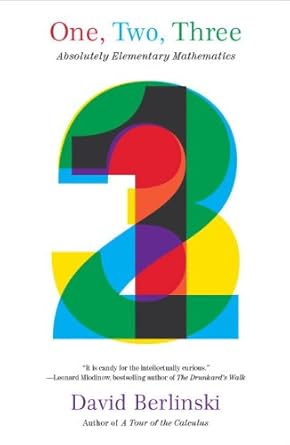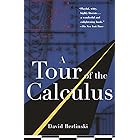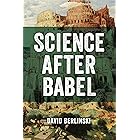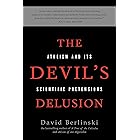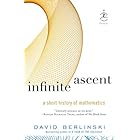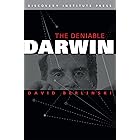Learn more
These promotions will be applied to this item:
Some promotions may be combined; others are not eligible to be combined with other offers. For details, please see the Terms & Conditions associated with these promotions.
Audiobook Price: $13.78$13.78
Save: $5.79$5.79 (42%)
Your Memberships & Subscriptions

Download the free Kindle app and start reading Kindle books instantly on your smartphone, tablet, or computer - no Kindle device required.
Read instantly on your browser with Kindle for Web.
Using your mobile phone camera - scan the code below and download the Kindle app.



 Audible sample
Audible sample Follow the author
OK
One, Two, Three: Absolutely Elementary Mathematics Kindle Edition
From the acclaimed author of A Tour of the Calculus and The Advent of the Algorithm, here is a riveting look at mathematics that reveals a hidden world in some of its most fundamental concepts.
In his latest foray into mathematics, David Berlinski takes on the simplest questions that can be asked: What is a number? How do addition, subtraction, multiplication, and division actually work? What are geometry and logic? As he delves into these subjects, he discovers and lucidly describes the beauty and complexity behind their seemingly simple exteriors, making clear how and why these mercurial, often slippery concepts are essential to who we are.
Filled with illuminating historical anecdotes and asides on some of the most fascinating mathematicians through the ages, One, Two, Three is a captivating exploration of the foundation of mathematics: how it originated, who thought of it, and why it matters.
Customers who bought this item also bought
Editorial Reviews
Amazon.com Review
Leonard Mlodinow is a physicist at Caltech and the bestselling author of The Drunkard’s Walk: How Randomness Rules our Lives and Euclid’s Window: The Story of Geometry from Parallel Lines to Hyperspace. He also wrote for Star Trek: The Next Generation. He lives in South Pasadena, California. Read his review of One, Two, Three:
Fifteen years ago, if publishers were sure of anything, it was that (1) calculus is not funny, and (1+1) no one wants to go to lie in bed clutching a book about the concept and history of integral and differential operators. Then along came the always audacious David Berlinski (his bio described him as “having a tendency to lose academic positions with what he himself describes as an embarrassing urgency”). A mathematician who is by trade a purveyor of proofs, Berlinski wrote A Tour of the Calculus, proving the skeptics wrong on both counts. With One, Two, Three: Absolutely Elementary Mathematics, Berlinski has now applied his vast knowledge, wit, and inimitable trademark writing style to tackle another subject about as sexy as American cheese: arithmetic. But don’t worry, you won’t find any multiplication tables here--this is a book about what it means to multiply (and add, subtract, and divide). Berlinski challenges us to see these as deeper issues, a level of mathematical thinking that most people never consider, but which forms the very logical foundation upon which rest ideas as vital as one plus one equals two.
Is there more to arithmetic than its application through our rote rules of calculation? Berlinski describes how, beginning in the late nineteenth century, mathematicians got around to questioning the meaning of arithmetic, and searching for axioms upon which that structure might be placed. Then he guides us through their reasoning.
Numbers form the foundation of our universe, yet most of us never puzzle over what they mean. We take for granted our numbers, the operations we perform on them, and the rules, such as commutivity, that those operations follow. It all seems to work when we buy our cappuccino and croissant, so why question it, unless you get shortchanged? The truth is, we don’t question arithmetic because we are in that famous and unenviable position of not knowing the extent of what we do not know. But Berlinski educates us, and shows that the logical basis of arithmetic is worth knowing, and worth appreciating, for it is both beautiful and profound, and represents a grand feat of human imagination. It is the revelation of a world of ideas upon which the simplest counting and calculating--acts without which no planning or transactions, from engineering to commerce, could exist--is predicated. That is David Berlinski’s gift to the reader. It is candy for the intellectually curious.
(photo: Marcio Fernandes)
Review
—Kirkus Reviews
“With broad culture and wry humor, Berlinski takes a look at some basic concepts in math and the people who worried about them. A treat!”
—Gregory Chaitin, author of Meta Math!
“With wit and philosophy, with the clash of symbols and history, Berlinski displays the inner soul of simple arithmetic.”
—Philip J. Davis, professor emeritus of applied mathematics, Brown University
From the Hardcover edition.
About the Author
Excerpt. © Reprinted by permission. All rights reserved.
Introduction
This is a little book about absolutely elementary mathematics (AEM); and so a book about the natural numbers, zero, the negative numbers, and the fractions. It is neither a textbook, a treatise, nor a trot. I should like to think that this book acts as an anchor to my other books about mathematics.
Mathematicians have always imagined that mathematics is rather like a city, one whose skyline is dominated by three great towers, the state ministries of a powerful intellectual culture—our own, as it happens. They are, these great buildings, devoted to Geometry, Analysis, and Algebra: the study of space, the study of time, and the study of symbols and structures.
Imposing as Babylonian ziggurats, these buildings convey a sacred air.
The common ground on which they rest is sacred too, made sacred by the scuffle of human feet.
This is the domain of absolutely elementary mathematics.
Many parts of mathematics glitter alluringly. They are exotic. Elementary mathematics, on the other hand, evokes the very stuff of life: paying bills, marking birthdays, dividing debts, cutting bread, and measuring distances. It is earthy. Were textbooks to disappear tomorrow, and with them the treasures that they contain, it would take centuries to rediscover the calculus, but only days to recover our debts, and with our debts, the numbers that express them.
Elementary mathematics as it is often taught and sometimes used requires an immersion into messiness. Patience is demanded, pleasure deferred. Decimal points seem to wander, negative numbers become positive, and fractions stand suddenly on their heads.
And what is three-fourths divided by seven-eights?
The electronic calculator has allowed almost everyone to treat questions such as this with an insouciant indifference. Quick, accurate, and cheap, it does better what one hundred years ago men and women struggled to do well. The sense that in elementary mathematics things are familiar—half remembered, even if half forgotten—is comforting, and so are the calculator and the computer, faithful almost to a fault, but the imperatives of memory and technology do prompt an obvious question: why bother to learn what we already know or at least thought we knew?
The question embodies a confusion. The techniques of elementary mathematics are one thing, but their explanations are quite another. Everyone can add two simple natural numbers together—two and two, for instance. It is much harder to say what addition means and why it is justified. Mathematics explains the meaning and provides the justification. The theories that result demand the same combination of art and sophistication that is characteristic of any great intellectual endeavor.
It could so easily have been otherwise. Elementary mathematics, although pressing in its urgency, might have refused to cohere in its theory, so that, when laid out, it resembled a map in which roads diverged for no good reason or ended in a hopeless jumble. But the theory by which elementary mathematics is explained and its techniques are justified is intellectually coherent. It is powerful. It makes sense. It is never counter-intuitive. And so it is appropriate to its subject. If when it comes to the simplest of mathematical operations—addition again—there remains something that we do not understand, that is only because there is nothing in nature (or in life) that we understand as completely as we might wish.
Nonetheless, the theory that results is radical. Do not doubt it. The staples of childhood education are gone in the night. One idea is left, and so one idea predominates: that the calculations and concepts of absolutely elementary mathematics are controlled by the single act of counting by one. There is in this analysis an economy of effect, and a reduction of experience to its essentials, as dramatic as anything found in the physical sciences.
Until the end of the nineteenth century, this was not understood. A century later, it is still not widely understood. School instruction is of little help. “Please forget what you have learned in school,” the German mathematician Edmund Landau wrote in his book Foundations of Analysis; “you haven’t learned it.”
From time to time, I am going to ask that readers do some forgetting all their own.
A secret must now be imparted. It is one familiar to anyone writing about (or teaching) mathematics: no one very much likes the subject. It is best to say this at once. Like chess, mathematics has the power to command obsession but not often affection.
Why should this be—the distaste for mathematics, I mean?
There are two obvious reasons. Mathematics confronts the beginner with an aura of strangeness, one roughly in proportion to its use of arcane symbols. There is something about mathematical symbolism, a kind of peevishness, that while it demands patience, seems hardly to promise pleasure.
Why bother?
If the symbolic apparatus of mathematics is one impediment to its appreciation, the arguments that it makes are another. Mathematics is a matter of proof, or it is nothing. But certainty does not come cheap. There is often a remarkable level of detail in even a simple mathematical argument, and, what is worse, a maddening difference between the complicated structure of a proof and the simple and obvious thing it is intended to demonstrate. There is no natural number standing between zero and one. Who would doubt it? Yet it must be shown, and shown step by step. Diffi cult ideas are required.
Why bother?
A tricky bargain is inevitably involved. In mathematics, something must be invested before anything is gained, and what is gained is never quite so palpable as what has been invested. It is a bargain that many men and women reject.
Why bother indeed?
The question is not ignominious. It merits an answer.
In the case of many parts of mathematics, answers are obvious. Geometry is the study of space, the mysterious stuff between points. To be indifferent to geometry is to be indifferent to the physical world. This is one reason that high-school students have traditionally accepted Euclid with the grudging sense that they were being forced to learn something that they needed to know.
And algebra? The repugnance (in high school) that this subject evokes has always been balanced by the sense that its symbols have a magical power to control the flux and fleen of things. Farmers and fertilizers were the staple of ancient textbooks. But energy and mass figure in those that are modern. Einstein required only high-school algebra in creating his theory of special relativity, but he required high-school algebra, and he would have been lost without it.
Mathematical analysis came to the mature attention of European mathematicians in the form of the calculus. They understood almost at once that they had been vouchsafed the first and in some respects the greatest of scientific theories. To wonder at the importance of analysis, or to scoff at its claims, is to ignore the richest and most intensely developed body of knowledge acquired by the human race.
Yes, yes. This is all very uplifting, but absolutely elementary mathematics? Not very long ago, the French mathematician Alain Connes invented the term archaic mathematics to describe the place where ideas are primeval and where they have not yet separated themselves into disciplines. It is an elegant phrase, an apt description. And it indicates just why elementary mathematics, when seen properly, has the grandeur of what is absolute. It is fundamental, and so, like language, an instinctive gesture of the human race.
A theory of absolutely elementary mathematics is an account in modern terms of something deep in the imagination; its development over the centuries represents an extraordinary exercise in self-consciousness.
This is what justifies the bothering, the sense that, by seeing an old, familiar place through the mathematician’s eyes, we can gain the power to see it for the first time.
This is no little thing.
Product details
- ASIN : B004J4WKOC
- Publisher : Vintage (May 10, 2011)
- Publication date : May 10, 2011
- Language : English
- File size : 4.2 MB
- Text-to-Speech : Enabled
- Screen Reader : Supported
- Enhanced typesetting : Enabled
- X-Ray : Not Enabled
- Word Wise : Enabled
- Print length : 224 pages
- Best Sellers Rank: #645,958 in Kindle Store (See Top 100 in Kindle Store)
- Customer Reviews:
About the author

Discover more of the author’s books, see similar authors, read book recommendations and more.
Customer reviews
Customer Reviews, including Product Star Ratings help customers to learn more about the product and decide whether it is the right product for them.
To calculate the overall star rating and percentage breakdown by star, we don’t use a simple average. Instead, our system considers things like how recent a review is and if the reviewer bought the item on Amazon. It also analyzed reviews to verify trustworthiness.
Learn more how customers reviews work on AmazonCustomers say
Customers find the book interesting and entertaining to read. The writing style receives positive feedback, with one customer noting how the author weaves words to create images. The historical content receives mixed reactions, with some customers finding it makes simple concepts complicated.
AI-generated from the text of customer reviews
Select to learn more
Customers find the book entertaining and pleasant to read, with one customer noting its gossip-like insights into ancient history.
"...And, if it comes to that, why read about it? Because it's an amazing invention, DB made me see, and like a truly top notch teacher, he related it to..." Read more
"...a genius who can conjure up (for he is a magician with metaphors) new insights, moods and nuances using words as precisely as razor sharp..." Read more
"...This book will provide you with gossip-like insight in to ancient history, but no deep understanding of anything, especially not how problems and..." Read more
"INTERESTING BOOK; GOOD CONDITION; QUICK DELIVERY." Read more
Customers appreciate the writing style of the book, with one mentioning how the author weaves words to create vivid images.
"...math in this book in order to read the writing, which is erudite and lyrical...." Read more
"This book is for people who are interested in fundamental math and love poetry and the ways it can weave words to create images and feelings that..." Read more
"...Berlinski is an excellent writer." Read more
"...While I'll give it 2 stars for Berlinski's writing style is great as always...." Read more
Customers have mixed reactions to the historical content of the book, with some finding it makes simple concepts complicated, while others appreciate its historical overview.
"...But there are some terse bits in the history of mathematics that tie everything together...." Read more
"...new insights, moods and nuances using words as precisely as razor sharp mathematical concepts...." Read more
"...you with gossip-like insight in to ancient history, but no deep understanding of anything, especially not how problems and solutions were discovered...." Read more
"...The professor surprised me with the vast subtlety of the natural numbers, and with the engaging humanity of the mathematicians who explored that..." Read more
Top reviews from the United States
There was a problem filtering reviews. Please reload the page.
- Reviewed in the United States on March 1, 2012Numerous students, I'm convinced, have a mental block against either English or math. Mine is the latter, which is why I'm not a physicist, despite being attracted to physics. I did first pick up "A Tour of the Calculus" hoping to at some point along the way unravel the mystery of it's subject A Tour of the Calculus. But this book I picked up purely from my English major desire to read more Berlinski. Odd as it sounds, I simply put up with all the math in this book in order to read the writing, which is erudite and lyrical. Along the way, however, the author started getting around my defenses, and I started following the formulas. Why is a whole 'nother paragraph.
Berlinski anticipates, and voices, the reader's (or at least this reader's) questions and objections along the way. Yes, I learned the number line. But why is there a number line? And, if it comes to that, why read about it? Because it's an amazing invention, DB made me see, and like a truly top notch teacher, he related it to counting, which has forever taken on a sort of golden glow for this reader, and showed how it can even handle the negative numbers, themselves an amazing invention. That would have been enough, but there's more. And it's even more elementary or primal. "The calculations and concepts of absolutely elementary mathematics are controlled by the single act of counting by one." You're kidding! I'm hooked, and that's only page five.
There aren't many of the long, lyrical portraits that seem drawn from forgotten novels that are so prevalent in "Calculus", although they start sprouting in the second half of the book. But there are some terse bits in the history of mathematics that tie everything together. It's even possible to "do some forgetting" and see these discoveries afresh, and feel their attendant excitement. But also, revisiting the classroom scenes, Berlinski asks the questions students form but don't put, and shows how to get to the answers teachers might not give. It's truly exciting to see the relations between the various operations of addition, subtraction, multiplication and division, and the various proofs that work for some of these and not others, with Berlinski explaining and showing why this would be the case. Moreso, how this led to things before I only knew the names of: sets, and rings, and succession, and fields, and, in the tantalizing realm of physics, Planck's length.
I knew of the mysterious properties of zero from reading about binary, heretofore the most interesting and fruitful mathematical idea I had encountered, but Berlinski's discussion of zero opens onto endless vistas. He brings up base 10 and the decimal system, but not in a discussion of bases (binary doesn't figure in anywhere). rather, of exponents and logarithms. This last always seemed to me to be entirely arbitrary, but his brief once over clears it right up, and he doesn't even delve into sines and cosines. That's how absolutely elementary this mathematics is. Which makes for absolutely engaging reading.
- Reviewed in the United States on February 4, 2015This book is for people who are interested in fundamental math and love poetry and the ways it can weave words to create images and feelings that are new to the reader. New experiences not just new concepts! Some people will always find fault with those whose thought processes are different than theirs. This book is very irritating to those who resent "fancy language" and feel that words they personally do not already know are more words than the English language really needs.
Berlinski is a genius who can conjure up (for he is a magician with metaphors) new insights, moods and nuances using words as precisely as razor sharp mathematical concepts. Prosaic souls require that the meaning of a Berlinski sentence unfold itself in their minds instantaneously - or else the fault is Berlinski's. They accuse him of ostentation when he displays greater mastery of the English language than they possess. Criticism of “mystical-type statements…which did not say anything extraordinary” reveals the intellectual poverty of the critic, not any failing of the poet. They resent the effort required to think a new thought forged in a new form, not noticing the enormous intellectual content whose essence could never be reduced to computer input. A strictly either/or mind, a digital consciousness, cannot abide ambiguity. For example, if someone criticizes Darwin then he must be a “creationist,” a most damning epithet in the mind of a “modern” critic. Such an accusation is absurd given Berlinski’s intellectual biography and self-described agnosticism.
Berlinski is basically a poet who loves mathematics and science. This is a great book that will be in print for decades because it brings more than mere concepts; it brings us new experiences by means of words.
- Reviewed in the United States on July 23, 2015The 4 stars is a tip that the book may not please everyone as much as it did me--especially anyone who may mistakes 123 Absolutely Elementary Mathematics for a simple explanation of mathematic operations. The book is a 5-star meander back through the centuries of human endeavor. It is a tour in which Dr. Berlinski took me back to the beginning of arithmetic operations and made me experience that story as an unfolding perception of elementary mathematics developing through the centuries. We looked on as its progenitors engaged simple numbers and their properties and determinedly advanced understanding of mathematics to the achievement it is today. The tour revealed the touching history of men and women wrestling with abstruse implications and theories to bring forward to succeeding generations the well proven and elegant tool Dr. Berlinski calls Absolutely Elementary Mathematics--AEM for short. The professor surprised me with the vast subtlety of the natural numbers, and with the engaging humanity of the mathematicians who explored that arcane realm. I had needed this book as a summer reading assignment before entering junior high school--the mathematics taught in classrooms might have yielded something to me. But, it is still a helpful thing to have my understanding of numbers and math embellished now. Thanks, Professor Berlinski.
- Reviewed in the United States on November 24, 2019If you want to know what this book is about read the last paragraph of the book’s description: historical anecdotes. Berlinski seems to be in love with the philosophy and history of math, bordering on religious fervor. This book will provide you with gossip-like insight in to ancient history, but no deep understanding of anything, especially not how problems and solutions were discovered. If you like cocktail hour discussion of Absolutely Elementary Mathematics (the author’s phrase) this book is for you. For me, it was deeply disappointing.
- Reviewed in the United States on March 5, 2024INTERESTING BOOK; GOOD CONDITION; QUICK DELIVERY.
Top reviews from other countries
 M. A. PellReviewed in the United Kingdom on January 15, 2015
M. A. PellReviewed in the United Kingdom on January 15, 20155.0 out of 5 stars Maths refresher
A useful starter book for people who want to refresh their Mathematics skills and knowledge. The author has written some other books that are worth looking at.



